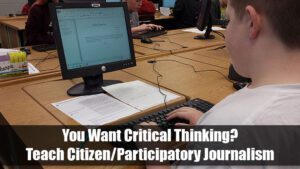
As a former newspaper reporter, I have a soft spot in my heart for telling people’s stories. As a teacher, I love guiding people through the process of sharing their own stories. However, one of the things I’ve found difficult to do is convince pre-teens that they have a story to tell. It’s even more difficult to convince them of how important it is for them to share that story with others.
Yesterday, a blog post by Brett Dickerson of Life at the Intersections highlighted for me how important this skills is. He wrote about how blogs written by educators have been critical to saving public education.
Mr. Dickerson says:
Over the last ten years, bloggers have kept the issues of who controls schools at the forefront when so many big money interests want desperately to have us look the other way.
One advantage that school raiders have in taking public schools away from the public and turning them over to investor-owned charters is that the traditional news sources are hobbled from reporting accurately and fully.
On the other hand, in Oklahoma, blogs have been the spine of exposing the lies and game plan of school raiders who have used big money from investors to attack public schools and promote charter and voucher schemes.
As a writer in the #Oklaed blogosphere and participant in the related Twittersphere, I have felt the power of my words in building community and opening conversations with like-minded people, and using those connections to demand change in a civically responsible way. As a scholastic, collegiate and professional newspaper reporter, I was able to inform my audiences about events, people, and decisions that enabled them to be more informed as they participated in our democratic society.
What educators are experiencing in Oklahoma, and what I strive for my students to embrace, is called citizen, or participatory, journalism.
Mark Glaser, a freelance journalists who has written about issues related to citizen journalism, stated in 2006:
The idea behind citizen journalism is that people without professional journalism training can use the tools of modern technology and the global distribution of the Internet to create, augment or fact-check media on their own or in collaboration with others. For example, you might write about a city council meeting on your blog or in an online forum. Or you could fact-check a newspaper article from the mainstream media and point out factual errors or bias on your blog. Or you might snap a digital photo of a newsworthy event happening in your town and post it online. Or you might videotape a similar event and post it on a site such as YouTube.
With the demise of school journalism courses and independent print newspapers, I believe this ability to tell engaging, informative, and socially responsible stories is being lost. I took my first journalism-related course when the yearbook advisor, principal and my 7th grade English teacher called me to the office during the first week of my 8th grade year, and told me they wanted me to be on the yearbook staff. The next year, I took Introduction to Journalism and served on the mid-high newspaper staff. I continued serving on my school newspapers, ending my scholastic career as the Opinion Editor of The Jag Wire at Westmoore High School. That’s four years of experience covering news before I ever entered college.
At the collegiate level, I worked for The Bison Newspaper at Oklahoma Baptist University for five years, serving as Editor, Managing Editor, and News Editor. I began working for The Shawnee News-Star in 1993 and served several communities as a professional reporter for six years. My goal: Provide the public with the information and stories they need to make informed decisions as citizens of our world.
Students don’t have these opportunities any more at many schools. It doesn’t help that students are fed a constant diet of insipid and paparazzi-infected drivel from news stations and other sources who are only wanting eyeballs to improve ratings.
This is why I am starting a classroom blog for my students, particularly those in my middle school Mixed Media Journalism and English Language Arts classes. I am teaching them how to write for a blog, how to investigate the world around them, how to organize informative and persuasive articles, how to recognize an important story when they see it (based on the five characteristics of news), and how to collaborate with one another.
The blog is still in its early stages, but I will be sharing work from it, and I would love to work with other teachers around the world who are attempting to teach the same skills to their students. Feel free to share your students’ blogs below. Perhaps our students can collaborate via blog comments to better each other’s reporting and writing skills.

I would be very interested in reading the classroom blog you talked about as well as hearing more about the mixed media journalism class you teach. They sound like tremendous opportunities for your students.
Thank you very much, Carey. My classroom blog is still a work in progress, but once we have some of our works published, I’ll link to some of their work. I can’t wait to see what they do!